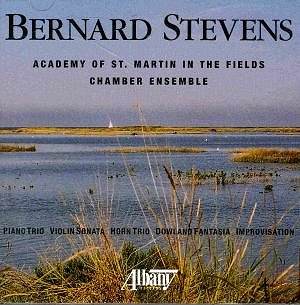Bernard Stevens' representation on CD continues
to unfold slowly but with satisfying thoroughness driven by his
widow's indomitable commitment and the intrinsic worth of the
music. The two concertos (violin, cello) and the two symphonies
(No. 1 , Liberation and No. 2) are on a pair of Meridian CDs (CDE84174,
CDE84124). The Piano Concerto is on Marco Polo. Albany is the
home of CDs of the extraordinarily powerful two String Quartets
(TROY455), the opera The Shadow of the Glen (TROY418) as
well as the present disc.
Stevens’ music suffered the eclipse that was
the fate of a tonal composer reaching maturity in the 1940s and
1950s. In the broadest sense he can be treated as a 'Cheltenham
man’ along with such diverse characters as Butterworth, Alwyn,
Veale and Gardner at one melodic extreme and Frankel, Fricker
(now there’s a man who deserves a CPO intégrale!) and Searle
at the atonal other with Rawsthorne somewhere in between.
The Piano Trio's motoric rhythms touch
on Bartók and Bloch giving way to an impassioned almost
cinematic intensity in the slow movement. A chucklingly avuncular
allegro con brio takes time to enjoy the scenery before
returning to intimations of East European angst. A startlingly
Howells-like passionate cantabile rounds off the work.
The Violin Sonata was written for and
dedicated to 'the onlie begetter' of this disc, Bertha Stevens
- the composer’s widow. This looks back to the John Ireland Second
Sonata and has those confidently hieratic sturdy piano statements
we associate with Ireland. It dates from two years before the
Piano Trio and lacks the East European-Hungarian tang of that
work. The piece ends calmly musing. It was Bertha Stevens' playing
of this fine and succinct work that attracted Max Rostal to commission
the Violin Concerto.
Unsurprisingly the Horn Trio was written
partially as a companion to the Brahms Trio. We are now almost
thirty years on from the Violin Sonata and the subtlety of expression
has deepened. Stevens uses an obsessive little four-note theme
- like a bird-call and deploys this freely amongst the instruments.
Its morose course tracks higher and higher until achieving the
violin's high F which leads into the second movement (also an
adagio). The movement is only 2.14 long. The trio play
the four-note motif caringly and give it a mid-European folksy
flavour which is picked up in the allegro finale.
The Dowland Fantasia was written
ten years after the Piano Trio. It was written for and premiered
by Suzanne Rozsa and Paul Hamburger. The theme is Dowland’s galliard
Can Shee Excuse. It nicely complements his Fantasia
on Farnaby's Dream. The pieces muses reflectively and also
dances lightly on its Warlockian toes at 05.01 soon disporting
in neo-Bachian finery but moving onwards to the more impassioned
writing with which it closes.
The spare Improvisation for solo
violin is ingenious, cheeky though perhaps inevitably predominantly
serious. It began life as a work for solo viola composed in 1973
for his daughter Catherine. He wrote the present version for Erich
Gruenberg. Both versions happily co-exist.
There are plenty of Stevens works awaiting recording.
The cantatas have been methodically neglected though they promise
well going by a few off-air tapes I have heard. The range is wide:
Harvest of Peace (Randall Swingler) for soprano, baritone,
narrator, chorus and string orchestra and piano (1952), Pilgrims
of Hope (William Morris) for soprano, baritone, chorus
and orchestra (1956), Thanksgiving (Tagore) for SATB chorus
and string orchestra (1965), Et Resurrexit (Ecclesiastes
and Swingler) for alto, tenor, chorus and orchestra (1969), Hymn
to Light (Tagore) for baritone, chorus, orchestra and piano
(1971) and The Turning World (Swingler) for baritone solo,
chorus and orchestra and piano (1971).
This Stevens collection is most engagingly documented
by Malcolm Macdonald who also wrote the chapter on Stevens' chamber
music in the Kahn & Averill symposium on 'Stevens and His
Music' (1989, ISBN 1-871082-03-X).
Stevens was never a pastoralist but instead focused
on traditional forms of absolute music working within the agreeable
confines of tonality. He was not at all 'grey'; and there is not
a trace of the neo-classical or the avant-garde. He perhaps can
be seen as a British echo of the line established by Bloch and
Rozsa - more the former than the latter. The Piano Trio and Violin
Sonata catch him at his most instantly approachable without being
in any way ingratiating. As ever Stevens impresses by his patent
sincerity. You take him or you leave him. He wrote as he found
... you cannot ask more of a composer. Long may the Stevens Trust
continue their valuable work. This disc, the Albany String Quartets
and Meridian Violin Concerto are good places to start exploration
of the Stevens legacy.
Rob Barnett
